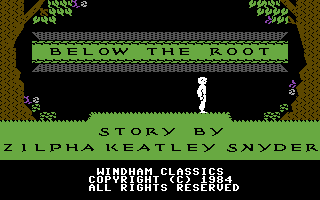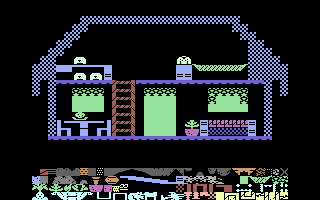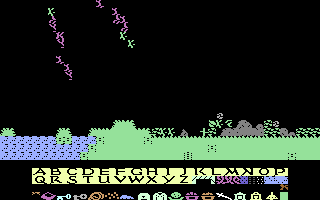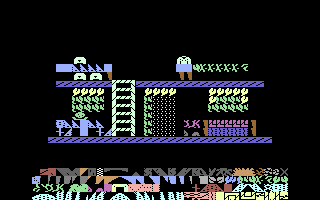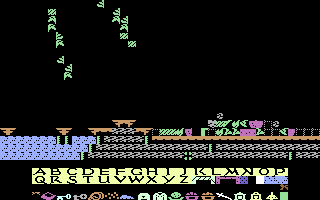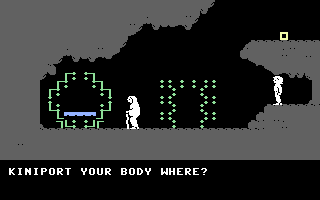Below the Root
| Below the Root |
|---|
|
Developer: Dale Disharoon
|
| This page or section needs more images. There's a whole lotta words here, but not enough pictures. Please fix this. |
Level Editor
There is a level editor hidden in the code in the Commodore 64 version. It is not complete and will not allow screens to be saved, but it may be used to teleport around the game map.
To access it, from VICE enter g 9000 in the monitor. The USE WHAT? prompt will appear; clear it and you will be in the editor.
Keys:
- 1, 2, 3 - Change some colors of elements.
- Holding down 6 or 8 while moving the joystick changes the colors of some objects (like pressing 1,2 & 3).
- C - Changes only the color of the signs and letters.
- F - Switch the tilesets at the bottom of the screen between characters 0-127 and 128-255.
- L - Load screen from disk. Select the screen first by clicking with the joystick on the 5th row of the screen from the bottom. The numbering is 0-31 on the top row, then 32-63, and so on to 480-511 for the bottom row. Many low-numbered screens are building interiors and the screens 125, 126, 157, and 158 are the 4-screen introduction area. L also lets you preview the tileset graphics which quickly reverts back to ASCII numbers and characters.
- S - Appears to have supposed to save, but seems to be dummied out. The original screen is restored right before the disk is accessed currently.
- T - Quit to main menu.
- X - Switch between above-ground and below-ground/interiors of buildings graphics sets.
- E - Some combination of E (erases screen) and then C and F changes the default colors of the tileset (i.e. shapes default to brown for drawing trees instead of grey for rocks).
To use it to warp, just change the screen by pushing the joystick button when the cursor is on the 5th row from the bottom. The border will turn red and you can use the joystick to adjust the screen number by 1 or 10 at a time in either direction. Then, press the joystick button again. Now hit T on the keyboard to quit and select CONTINUE from the next menu to warp your character.
It doesn't always work; you should always warp from an outdoor screen to another outdoor screen or an indoor screen to another indoor screen. However, the title screen rooms are considered "indoors" even though they're obviously outside, probably so you wouldn't access them by gliding in the wrong places usually. If you access an "indoor" room while the game thinks you to be outdoors, the screen will be empty instead. Entering the intro area will sometimes give odd dialogue for the 2 animals.
During regular gameplay, when you use the Kiniport skill, the little square that appears is the same as the level editor square. This means that the level editor's code is actually used during the game, and is therefore probably in the Apple II and PC versions as well.
An 8x8-pixel square appears which can be moved around the screen. During the game, it is used to teleport objects by first clicking on the object and then the destination. In the editor, an image from the tileset can be chosen and then drawn on the map using the square.
The discovery of the level editor allows mapping all 512 screens. The editor reveals room interiors and intro screens as part of the same giant map, but in the areas inaccessible during normal gameplay. Computing power would not have allowed this kind of composite in 1984, and seeing all the screens laid out reveals some interesting details. There is some duplication of levels, and one screen consisting of only a few floor lines that appears to be an aborted drawing (far right near the bottom).
There are several black screens where there is no content (including screens 500-511). The level editor locks up when you go there, and you have to restart it again by typing g 9000 in VICE's monitor.
Strangely, the final screen where you find Raamo (the guy you are looking for Below the Root), does not appear there. Instead, it is in the sky. There are some levels that are duplicated, some in the sky and some on the map. There is one level that appears to be an aborted drawing, with just a few floor lines laid out.
The duplication and aborted level were probably simply due to confusion, since they probably didn't have a way to see every screen at once, and so they may have forgotten to erase the duplicate (upper left entrance to the underground is duplicated in the bottom part, but is inaccessible from there).
Cleanup > Needs more images
Cleanup > Pages missing date references
Cleanup > Pages missing developer references
Cleanup > Pages missing publisher references
Games > Games by content > Games with debugging functions
Games > Games by developer > Games developed by Dale Disharoon
Games > Games by platform > Commodore 64 games
Games > Games by publisher > Games published by Windham Classics
Games > Games by release date > Games released in 1984
